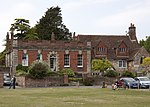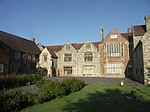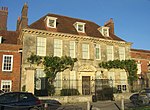Arundells
2008 establishments in EnglandBiographical museums in WiltshireGrade II* listed buildings in WiltshireGrade II* listed housesHistoric house museums in Wiltshire ... and 7 more
Houses completed in 1699Houses in WiltshireMuseums established in 2008Museums in SalisburyPrime ministerial homes in the United KingdomQueen Anne architecture in the United KingdomUse British English from April 2014

Arundells is a Grade II* listed house at 59 Cathedral Close, Salisbury, Wiltshire, England. Located on the West Walk of the Close, next to the 'Wardrobe' (Rifles Museum), it was the home of Edward Heath, the former Prime Minister of the United Kingdom, from 1985 until his death in 2005. The house and its extensive garden are open to the public five days a week from late March to late October each year.
Excerpt from the Wikipedia article Arundells (License: CC BY-SA 3.0, Authors, Images).Arundells
West Walk, Salisbury Harnham
Geographical coordinates (GPS) Address Website External links Nearby Places Show on map
Geographical coordinates (GPS)
| Latitude | Longitude |
|---|---|
| N 51.0659 ° | E -1.7999 ° |
Address
Arundells
West Walk 59
SP1 2EZ Salisbury, Harnham
England, United Kingdom
Open on Google Maps










